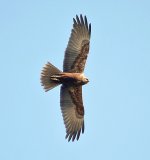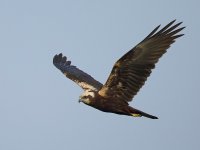JayFeatherPL
Well-known member

Looking through photos of female western marsh harriers on the Internet, I noticed that some females have the underside of their wings completely dark and plain, while others have dark underside wing covert feathers (shoulders) and light remiges. The latter are therefore similar to common buzzards. So here is the question: what does the color of the underside of the remiges depend on, and how to distinguish those females with lighter remiges from common buzzards?
First photo: Female with light remiges and dark shoulders
Second photo: Female with completely dark underside of the wings
(These are not my photos, the first photo is from polish Wikipedia and the second one is from eBird - western marsh harrier, made by Albin Jacob)
First photo: Female with light remiges and dark shoulders
Second photo: Female with completely dark underside of the wings
(These are not my photos, the first photo is from polish Wikipedia and the second one is from eBird - western marsh harrier, made by Albin Jacob)







